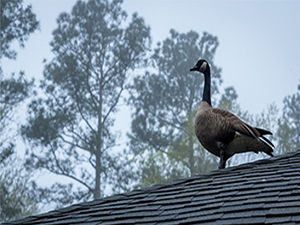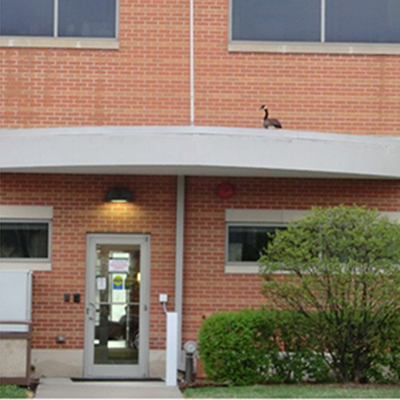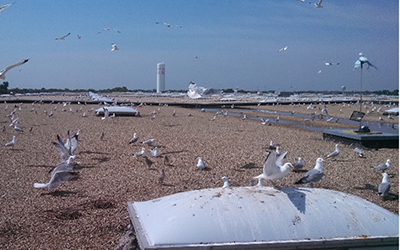Keep Your Rooftop Goose and Gull Free This Nesting Season
Mar 21, 2023
Goose and gull nesting season is upon us, which means flat, elevated surfaces are currently prime real estate for birds looking to lay, incubate and hatch their eggs.
Both bird species display a preference for nesting on rooftops, where they have a clear vantage point and can more easily avoid predators. Nests can be found anywhere from the corner of a rooftop to awnings, and elevator shafts to underneath or inside of HVAC units.
Property managers should plan ahead and monitor for potential nesting birds now: as the season wears on, nesting geese and gulls become increasingly territorial and aggressive. And, despite the hazard they can pose to properties and humans, removing nesting birds and their eggs requires more than a simple eviction notice.
Here is what to look for and how to respond if feathered tenants make a temporary home on your roof.
How to Monitor for Nesting Geese on Rooftops
Geese follow predictable nesting patterns each year, so there are several telltale signs they may be eyeing your roof.
Geese begin nesting season by staking out their territory. If you spot a pair of geese hanging around your property in February and March, your roof may be at risk. That risk is heightened if geese have nested on your rooftop in the past: geese, especially older ones, are likely to return to a spot where they nested in previous years.
If you notice a pair of loitering geese getting into altercations with other geese on your property, it is a clear indication that the aggressors are serious about nesting nearby.

If, after some time, you only see one of the pair of geese your property, it is likely that a nest has been established. Chances are, the remaining goose is the male standing guard and at the ready to defend his mate and unhatched goslings.
If the male becomes aggressive towards humans, it is further evidence that a nest has been established. Attacks are common when the female is sitting on the nest, even if she and her eggs are safely hidden on the roof. Simply being in the general vicinity of a nest is enough to provoke a goose attack.
If action is not taken to remove geese and their eggs before they hatch, the parents are likely to become even more aggressive. Once the goslings arrive, parents exhibit extremely defensive behavior until the babies can fly.
How to Monitor for Nesting Gulls on Rooftops

Like geese, it is relatively easy to detect whether gulls are attempting to nest on your roof if you know what to look for.
As birds of habit, gulls prefer to nest in familiar spots. If gulls have nested on your roof in the past, it is likely they will return.
If you notice an uptick in loafing birds, noise, droppings and debris on your property in March and April, you can assume that gulls are staking out and claiming territory over your roof.
Unlike geese, who tend only to nest in pairs, entire colonies of gulls sometimes nest together. Left uncontrolled, your roof could house anywhere from a single pair of gulls to an entire colony of them with thousands of birds and nests.
Once they have nested, gulls will make their presence known by assaulting humans who approach the roof, even at street level. Attacks can range from swooping down while shrieking, to defecating on individuals, to knocking people to the ground.
Call in Experts to Manage Geese and Gulls Nesting on Your Roof
If you notice geese or gulls staking out or marking territory near your property, it is important to act quickly. Deterrents have proven to be effective, but are not the only solution to nesting, as birds are great at adapting to change.
For the best outcome, contact an expert with deep knowledge of bird biology and behavior to devise a plan. Goose and gull removal and egg depredation requires permitting and planning, so it is advisable to call in expert help as soon as you suspect birds are attempting to nest on your property. Once eggs hatch, removal options are limited.
The Wild Goose Chase team has extensive experience managing problem geese and gulls. Our team of professionals has evicted scores of nesting birds from rooftops and has expert-level knowledge of the multi-agency permitting requirements for deprecating eggs and relocating birds.
If you’ve noticed an increase in loitering geese and gulls on your property, don’t wait. Connect with our team today to learn about your options.




 0
0
